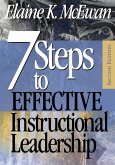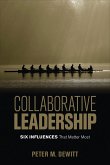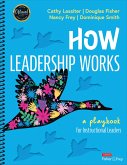24,99 €
inkl. MwSt.
Versandfertig in über 4 Wochen

12 °P sammeln
- Broschiertes Buch
- Merkliste
- Auf die Merkliste
- Bewerten Bewerten
- Teilen
- Produkt teilen
- Produkterinnerung
- Produkterinnerung
This step-by-step how-to guide presents the six driving forces of instructional leadership within a multi-stage model for implementation, delivering lasting improvement through small, collaborative changes.
Andere Kunden interessierten sich auch für
![Seven Steps to Effective Instructional Leadership Seven Steps to Effective Instructional Leadership]() Elaine K. McEwan-AdkinsSeven Steps to Effective Instructional Leadership42,99 €
Elaine K. McEwan-AdkinsSeven Steps to Effective Instructional Leadership42,99 €![Impact Players Impact Players]() Liz WisemanImpact Players29,99 €
Liz WisemanImpact Players29,99 €![Collaborative Leadership Collaborative Leadership]() Peter M. DeWittCollaborative Leadership32,99 €
Peter M. DeWittCollaborative Leadership32,99 €![Values for Educational Leadership Values for Educational Leadership]() Graham HaydonValues for Educational Leadership68,99 €
Graham HaydonValues for Educational Leadership68,99 €![How Leadership Works How Leadership Works]() Cathy J. LassiterHow Leadership Works43,99 €
Cathy J. LassiterHow Leadership Works43,99 €![Principal Leadership for Racial Equity Principal Leadership for Racial Equity]() Candace RaskinPrincipal Leadership for Racial Equity46,99 €
Candace RaskinPrincipal Leadership for Racial Equity46,99 €![Stories of Caring School Leadership Stories of Caring School Leadership]() Mark A. Smylie (USA University of Illinois at Chicago)Stories of Caring School Leadership35,99 €
Mark A. Smylie (USA University of Illinois at Chicago)Stories of Caring School Leadership35,99 €-
-
-
This step-by-step how-to guide presents the six driving forces of instructional leadership within a multi-stage model for implementation, delivering lasting improvement through small, collaborative changes.
Hinweis: Dieser Artikel kann nur an eine deutsche Lieferadresse ausgeliefert werden.
Hinweis: Dieser Artikel kann nur an eine deutsche Lieferadresse ausgeliefert werden.
Produktdetails
- Produktdetails
- Verlag: SAGE Publications Inc
- Seitenzahl: 176
- Erscheinungstermin: 25. Februar 2020
- Englisch
- Abmessung: 254mm x 178mm x 10mm
- Gewicht: 350g
- ISBN-13: 9781544381411
- ISBN-10: 1544381417
- Artikelnr.: 58025664
- Herstellerkennzeichnung
- Libri GmbH
- Europaallee 1
- 36244 Bad Hersfeld
- gpsr@libri.de
- Verlag: SAGE Publications Inc
- Seitenzahl: 176
- Erscheinungstermin: 25. Februar 2020
- Englisch
- Abmessung: 254mm x 178mm x 10mm
- Gewicht: 350g
- ISBN-13: 9781544381411
- ISBN-10: 1544381417
- Artikelnr.: 58025664
- Herstellerkennzeichnung
- Libri GmbH
- Europaallee 1
- 36244 Bad Hersfeld
- gpsr@libri.de
Peter DeWitt (Ed.D) is the founder and CEO of the Instructional Leadership Collective. He was a K-5 teacher for 11 years and a principal for 8 years. For the last 10 years, he has been facilitating professional learning nationally, and internationally, based on the content of many of his best-selling educational books. DeWitt¿s professional learning relationships are a monthly hybrid approach that includes both coaching and the facilitating workshops on instructional leadership and collective efficacy. Additionally, in the Summer of 2021, DeWitt created a year long on-demand, asynchronous coaching course through Thinkific where he has created a community of learners that include k-12 educators in leadership positions. DeWitt¿s work has been adopted at the state level, university level, and he works with numerous school districts, school boards, regional networks, ministries of education around North America, Australia, Europe, Asia, the Middle East and the U.K. Peter writes the Finding Common Ground column for Education Week, which has been in circulation since 2011. In 2020 DeWitt co-created Education Week¿s A Seat At the Table where he moderates conversations with experts around the topics of race, gender, sexual orientation, research, trauma and many other educational topics. Additionally, DeWitt is the Series Editor for the Connected Educator Series (Corwin Press) and the Impact Series (Corwin Press) that include books by Viviane Robinson, Andy Hargreaves, Pasi Sahlberg, Yong Zhao and Michael Fullan. He is the 2013 School Administrators Association of New York State¿s (SAANYS) Outstanding Educator of the Year, and the 2015 Education Blogger of the Year (Academy of Education Arts & Sciences), and sits on numerous advisory boards. Peter is the author, co-author or contributor of numerous books. Click on title to purchase. They include: Dignity for All: Safeguarding LGBT Students (Corwin Press. 2012). Flipping Leadership Doesn¿t Mean Reinventing the Wheel (Corwin Press. 2014) Collaborative Leadership: 6 Influences That Matter Most (Corwin Press/Learning Forward). School Climate: Leading With Collective Teacher Efficacy (Corwin Press/ Ontario Principals Council. 2017). Coach It Further: Using the Art of Coaching to Improve School Leadership (Corwin Press. 2018). Instructional Leadership: Creating Practice Out Of Theory (Corwin Press. 2020). Collective Leader Efficacy: Strengthening the Impact of Instructional Leadership Teams (Corwin Press. Learning Forward. 2021). De-implementation: Creating the Space to Focus on What Works (Corwin Press. 2022). Leading with Intention - Developing self-awareness to fostering an unreasonable human interconnectedness to impact the school community (co-authored with Michael Nelson. Corwin Press. 2024). Peter¿s articles have appeared in educational research journals at the state, national and international level. His books have been translated into numerous languages. Some of the organizations Peter has worked with are the American Association of School Administrators (AASA), Learning Forward, National Association of Elementary School Principals (NAESP), University of Oklahoma, Cognition Education (New Zealand), Australian Council for Educational Leaders (ACEL), Victoria Department of Education (Australia), University of Rotterdam (Netherlands), Washington Association of School Administrators (WASA), Texas Association of School Administrators (TASA), the National Education Association (NEA), New Brunswick Teacher¿s Association (Canada), the National Association of Secondary School Principals (NASSP), Education Scotland (Scotland), Glasgow City Council (Scotland), Kuwait Technical College (Kuwait) the National Association of School Psychologists, ASCD, l'Association des directions et directions adjointes des écoles franco-ontariennes (ADFO), the Catholic Principals' Council of Ontario (CPCO), and the Ontario Principals' Council (OPC), National School Climate Center, GLSEN, PBS, NPR, BAM Radio Network, ABC, and NBC¿s Education Nation. Learn more about bringing Peter DeWitt to your school or district at petermdewitt.com
About the Companion Website
Why this book?
This Book's Features
Publisher's Acknowledgments
About the Author
Introduction
Tap Into Your True Inner Instructional Leader
Blog - Help! My Principal Says He's an Instructional Leader!
Chapter One: Instructional Leadership: A Holistic Approach
What the Research Says About Instructional Leadership
In the End
Study Guide Questions
Chapter Two: The Logic Behind Implementation
What Is Program Logic?
From Program Logic to Implementation Cycle
Implementation Multi-Stage Model
In the End
Study Guide Questions
Chapter Three: A Focus on Learning: Deepening Our Impact as Instructional
Leaders
Types of Learning: Knowledge vs. Skills
Levels of Learning: Surface, Deep, and Transfer
delete
Knowledge Dimensions
In the End
Study Guide Questions
Chapter Four: Student Engagement: From Alienation to Social-Emotional
Learning
Alienation
Social-Emotional Learning
Five Easy Steps to Social-Emotional Learning
Enabling Conditions
Blog - Educators Need Mindfulness. Their Mental Health May Depend on It.
In the End
Study Guide Questions
Chapter Five: Instructional Strategies: Exploring Surface, Deep, and
Transfer Learning
Academic Engagement
Blog - The Myth of Walkthroughs: Eight Unobserved Practices in Classrooms
Teacher Clarity
Classroom Discussion
Metacognition
In the End
Study Guide Questions
Chapter Six: Collective Efficacy: Easy to Define, Hard to Build?
Collective Teacher Efficacy: A Definition
Why Do We Need Collective Teacher Efficacy?
Blog - No Testing Week
No Testing Week
Leadership Efficacy
When Do We Build Collective Efficacy?
Why Is Collective Efficacy Hard to Build?
Collective Efficacy: A Program Logic Model
In the End
Study Guide Questions
Chapter Seven: Evidence: How Will You Evaluate Your Impact?
Evidence of Impact
Student Engagement Practices
Blog - Advisory Groups: Helping to Create a Positive School Climate
Instructional Leadership
In the End
Reflection Tool
Study Guide Questions
References
Index
Why this book?
This Book's Features
Publisher's Acknowledgments
About the Author
Introduction
Tap Into Your True Inner Instructional Leader
Blog - Help! My Principal Says He's an Instructional Leader!
Chapter One: Instructional Leadership: A Holistic Approach
What the Research Says About Instructional Leadership
In the End
Study Guide Questions
Chapter Two: The Logic Behind Implementation
What Is Program Logic?
From Program Logic to Implementation Cycle
Implementation Multi-Stage Model
In the End
Study Guide Questions
Chapter Three: A Focus on Learning: Deepening Our Impact as Instructional
Leaders
Types of Learning: Knowledge vs. Skills
Levels of Learning: Surface, Deep, and Transfer
delete
Knowledge Dimensions
In the End
Study Guide Questions
Chapter Four: Student Engagement: From Alienation to Social-Emotional
Learning
Alienation
Social-Emotional Learning
Five Easy Steps to Social-Emotional Learning
Enabling Conditions
Blog - Educators Need Mindfulness. Their Mental Health May Depend on It.
In the End
Study Guide Questions
Chapter Five: Instructional Strategies: Exploring Surface, Deep, and
Transfer Learning
Academic Engagement
Blog - The Myth of Walkthroughs: Eight Unobserved Practices in Classrooms
Teacher Clarity
Classroom Discussion
Metacognition
In the End
Study Guide Questions
Chapter Six: Collective Efficacy: Easy to Define, Hard to Build?
Collective Teacher Efficacy: A Definition
Why Do We Need Collective Teacher Efficacy?
Blog - No Testing Week
No Testing Week
Leadership Efficacy
When Do We Build Collective Efficacy?
Why Is Collective Efficacy Hard to Build?
Collective Efficacy: A Program Logic Model
In the End
Study Guide Questions
Chapter Seven: Evidence: How Will You Evaluate Your Impact?
Evidence of Impact
Student Engagement Practices
Blog - Advisory Groups: Helping to Create a Positive School Climate
Instructional Leadership
In the End
Reflection Tool
Study Guide Questions
References
Index
About the Companion Website
Why this book?
This Book's Features
Publisher's Acknowledgments
About the Author
Introduction
Tap Into Your True Inner Instructional Leader
Blog - Help! My Principal Says He's an Instructional Leader!
Chapter One: Instructional Leadership: A Holistic Approach
What the Research Says About Instructional Leadership
In the End
Study Guide Questions
Chapter Two: The Logic Behind Implementation
What Is Program Logic?
From Program Logic to Implementation Cycle
Implementation Multi-Stage Model
In the End
Study Guide Questions
Chapter Three: A Focus on Learning: Deepening Our Impact as Instructional
Leaders
Types of Learning: Knowledge vs. Skills
Levels of Learning: Surface, Deep, and Transfer
delete
Knowledge Dimensions
In the End
Study Guide Questions
Chapter Four: Student Engagement: From Alienation to Social-Emotional
Learning
Alienation
Social-Emotional Learning
Five Easy Steps to Social-Emotional Learning
Enabling Conditions
Blog - Educators Need Mindfulness. Their Mental Health May Depend on It.
In the End
Study Guide Questions
Chapter Five: Instructional Strategies: Exploring Surface, Deep, and
Transfer Learning
Academic Engagement
Blog - The Myth of Walkthroughs: Eight Unobserved Practices in Classrooms
Teacher Clarity
Classroom Discussion
Metacognition
In the End
Study Guide Questions
Chapter Six: Collective Efficacy: Easy to Define, Hard to Build?
Collective Teacher Efficacy: A Definition
Why Do We Need Collective Teacher Efficacy?
Blog - No Testing Week
No Testing Week
Leadership Efficacy
When Do We Build Collective Efficacy?
Why Is Collective Efficacy Hard to Build?
Collective Efficacy: A Program Logic Model
In the End
Study Guide Questions
Chapter Seven: Evidence: How Will You Evaluate Your Impact?
Evidence of Impact
Student Engagement Practices
Blog - Advisory Groups: Helping to Create a Positive School Climate
Instructional Leadership
In the End
Reflection Tool
Study Guide Questions
References
Index
Why this book?
This Book's Features
Publisher's Acknowledgments
About the Author
Introduction
Tap Into Your True Inner Instructional Leader
Blog - Help! My Principal Says He's an Instructional Leader!
Chapter One: Instructional Leadership: A Holistic Approach
What the Research Says About Instructional Leadership
In the End
Study Guide Questions
Chapter Two: The Logic Behind Implementation
What Is Program Logic?
From Program Logic to Implementation Cycle
Implementation Multi-Stage Model
In the End
Study Guide Questions
Chapter Three: A Focus on Learning: Deepening Our Impact as Instructional
Leaders
Types of Learning: Knowledge vs. Skills
Levels of Learning: Surface, Deep, and Transfer
delete
Knowledge Dimensions
In the End
Study Guide Questions
Chapter Four: Student Engagement: From Alienation to Social-Emotional
Learning
Alienation
Social-Emotional Learning
Five Easy Steps to Social-Emotional Learning
Enabling Conditions
Blog - Educators Need Mindfulness. Their Mental Health May Depend on It.
In the End
Study Guide Questions
Chapter Five: Instructional Strategies: Exploring Surface, Deep, and
Transfer Learning
Academic Engagement
Blog - The Myth of Walkthroughs: Eight Unobserved Practices in Classrooms
Teacher Clarity
Classroom Discussion
Metacognition
In the End
Study Guide Questions
Chapter Six: Collective Efficacy: Easy to Define, Hard to Build?
Collective Teacher Efficacy: A Definition
Why Do We Need Collective Teacher Efficacy?
Blog - No Testing Week
No Testing Week
Leadership Efficacy
When Do We Build Collective Efficacy?
Why Is Collective Efficacy Hard to Build?
Collective Efficacy: A Program Logic Model
In the End
Study Guide Questions
Chapter Seven: Evidence: How Will You Evaluate Your Impact?
Evidence of Impact
Student Engagement Practices
Blog - Advisory Groups: Helping to Create a Positive School Climate
Instructional Leadership
In the End
Reflection Tool
Study Guide Questions
References
Index







